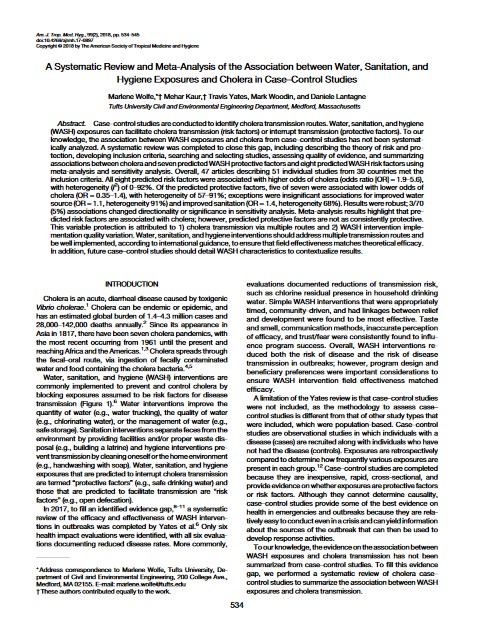A Systematic Review and Meta-Analysis of the Association between Water, Sanitation, andHygiene Exposures and Cholera in Case–Control Studies
 |
article coll. The American Journal of Tropical Medicine and Hygiene n° 99 Jun 2018 ; 12 pages
Aut. Daniele Lantagne & Mehar Kaur & Marlene Wolfe &
Ed. Tufts University - Boston
Downloadable format: PdF
Downloadable from the publisher
Editor Presentation
Abstract:
Case–control studies are conducted to identify cholera transmission routes. Water, sanitation, and hygiene (WASH) exposures can facilitate cholera transmission (risk factors) or interrupt transmission (protective factors). To our knowledge, the association between WASH exposures and cholera from case–control studies has not been systematically analyzed. A systematic review was completed to close this gap, including describing the theory of risk and pro-tection, developing inclusion criteria, searching and selecting studies, assessing quality of evidence, and summarizing associations between cholera and seven predicted WASH protective factors and eight predicted WASH risk factors using meta-analysis and sensitivity analysis.
Overall, 47 articles describing 51 individual studies from 30 countries met the inclusion criteria. All eight predicted risk factors were associated with higher odds of cholera (odds ratio [OR] = 1.9–5.6),with heterogeneity (I2)of0–92%. Of the predicted protective factors, five of seven were associated with lower odds of cholera (OR = 0.35–1.4), with heterogeneity of 57–91%; exceptions were insignificant associations for improved watersource (OR = 1.1, heterogeneity 91%) and improved sanitation (OR = 1.4, heterogeneity 68%). Results were robust; 3/70(5%) associations changed directionality or significance in sensitivity analysis. Meta-analysis results highlight that predicted risk factors are associated with cholera; however, predicted protective factors are not as consistently protective. This variable protection is attributed to 1) cholera transmission via multiple routes and 2) WASH intervention implementation quality variation. Water, sanitation, and hygiene interventions should address multiple transmission routes and be well implemented, according to international guidance, to ensure that field effectiveness matches theoretical efficacy. In addition, future case–control studies should detail WASH characteristics to contextualize results.
Keywords: |
health (CI) (DT) (ET) (ope) , hygiene (CI) (DT) (ET) (ope) , water (CI) (DT) (ET) (ope) |
Publisher/Broadcaster: |
|
Tufts University - Boston - Usa |
If there is a broken link, we will be pleased to receive a message: communication@pseau.org